YouTube Makes Adjustments to Its Moderation Guidelines
Posted in: UncategorizedThe changes allow controversial content to remain on YouTube as long as it is considered to be in the public’s interest.
The changes allow controversial content to remain on YouTube as long as it is considered to be in the public’s interest.
YouTube and Paramount Global recorded the highest month-to-month increases at 0.4%.
Broadcast and linear TV viewing segments grew for the month largely thanks to sports content.
YouTube remained in first place and had its best TV share ever, eclipsing the record it set in February.
Dodo Dream Date has been a success story for the company’s pet-themed brand.
If you’ve ever loved dad jokes, there’s a new show dedicated to celebrities telling them–and brands get the last laugh. Digital video network Culture Genesis premiered Celebrity Dad Jokes this week on the All Def channel on YouTube, which tapped Nick Cannon as an executive producer and the host. The show, which Culture Genesis describes…
With performance and measurement top of mind, brand safety is dropping down the list of priorities for marketers advertising on YouTube and connected TV. That’s according to a new study from Pixability, which surveyed U.S. media agency professionals who buy ads on video platforms. The survey asked the media buyers to rank the importance of…
YouTube is planning to roll out a lower-priced, ad-free version of its paid video service, and streamers and creators should stay tuned. The package, which includes podcasts and how-to videos, will be called “premium lite” and is soon to be announced in the United States, Australia, Germany, and Thailand, targeting viewers who want to watch…
The year was 2020 and while the rest of the world was grappling with a global pandemic, YouTube was having quite the year. The video platform saw the biggest growth in usage out of all the social media apps during the pandemic, with its user base growing from 73% of US adults in 2019 to…
To promote YouTube Music, which launched in the U.S. in November, YouTube is putting the spotlight on its biggest competitive advantage—its diversity.
Sure, Spotify has musical diversity. But YouTube is the No. 1 streaming music site in the world, which means it’s got an especially diverse user base. And it’s those people, and their unique and personal tastes, that the brand is focusing on.
Working with Lance Acord, the director behind a slew of hits including the NFL’s Super Bowl babies choir, YouTube has released a series of ads that embody the private moments in a day that music transforms into something special, even personally revealing.
![]()
This morning, on the heels of a monumental ruling by the Supreme Court in favor of marriage equality (no thanks to a bizarre, nonsensical dissent from Clarence Thomas), YouTube released a video celebrating the decision, and Pride Month, entitled “#ProudToLove.”
The video, directed by Scott Chan, opens with footage of individuals who used videos posted to YouTube as a way to come out. This highlights YouTube as not only a longtime supporter of LGBT rights, but also its role in acting as a supportive community for those who need it. As the spot continues, it mixes in footage both personal and political. One of these clips includes the line, “I hope you will stand on the right side of history,” an appropriate choice since the Supreme Court decision now makes it abundantly clear which side that is. It’s a fitting tribute to both the Supreme Court’s historical decision in favor of equality and to Pride Month. We expect to see a lot of brands follow in YouTube’s footsteps with their own celebratory messages, but this will likely stand as not only one of the first such efforts but also one of the best.
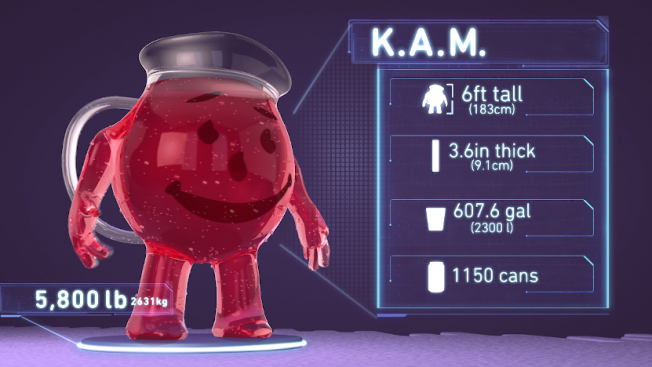
The Kool-Aid man’s explosive antics have been unquestionably cool since he busted through his first wall in the 1970s. But could he possibly survive such a dramatic entrance?
Wouldn’t he shatter when hitting a brick wall? What about the Kool-Aid inside—wouldn’t it slosh out? And let’s not forget that, best-case scenario, he’d be left with brick and mortar floating about in his innards.
These important questions have been fueling comedians and baffling stoners for years. But now YouTube superstar Jake Roper of the science-minded vlog VSauce decided to leave conjecture behind. Vsauce did the science to figure out if a 6-foot-tall anthropomorphic pitcher could actually break through a brick wall, and if so, what would be left of him.
Check out the results in the clip below, or, if you’re not up for a 4-minute clip on physics in the fictional world of advertising, skip down to our summary.
So in short, the answer is: Yes, Kool-Aid man could, though he probably wouldn’t feel too great afterwards.
It turns out that scaling an ordinary pitcher up to six feet, then filling it with the correct amount of Kool-Aid would make Kool-Aid Man an 11,000-pound elephant-sized beast with glass at least 3.6 inches thick. Even a creature made of ordinary glass would be able to break through a brick wall at that size by getting up to a run, but we don’t actually know what kind of glass Kool-Aid Man is made from. Heck, he could be made from Pyrex.
Nonetheless, the video explores how laminated glass (the bullet-proof stuff) would help him survive the inevitable surface cracks from his wall-breaking feats, but it doesn’t cover fully tempered glass, heat-strengthened material or any of the many other glass varieties. Certainly, there’s a materials scientist out there who could, with enough zeal, create the proper thickness, tempering and coating combination that would let Kool-Aid man break through more than just one wall.
However, there’s still the matter of vital fluid loss and contamination from brick debris. All of which suggests that the safest route for our beloved behemoth would be to respect other people’s property and use the damn door. Of course, given that he’s the size of an elephant and weighs as much as two Dodge Durangos, he can probably do whatever he wants.
![]()
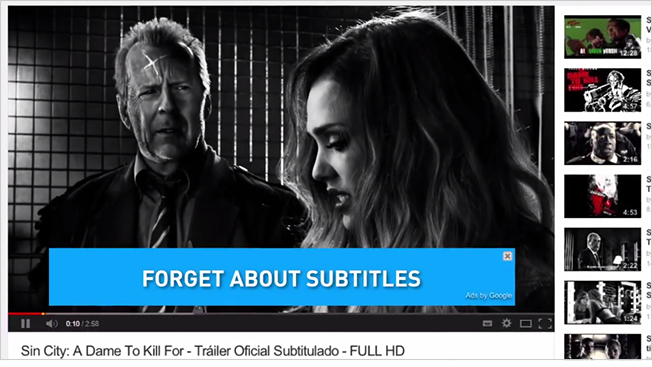
Learning a new language is never easy, and for many Peruvians, it’s a lot easier to just read the Spanish subtitles on their favorite U.S. movie trailers.
Armed with that insight, language school Euroidiomas has been trolling these viewers with clever YouTube banner ads that covered subtitles on movie promos and urged them to sign up for English classes.
“The action’s up there, not down here,” notes one ad.
“Go to watch movies, not to read them,” says another.
Clever as they may be, it’s unlikely they worked very well if (as in the case study below) the ads were written in English. We’re going to guess the real ads were in Spanish and that this version was just created for us English speakers to appreciate the campaign.
Now, if we’re done, I’d like to get back to this Tortugas Ninjas trailer.
![]()
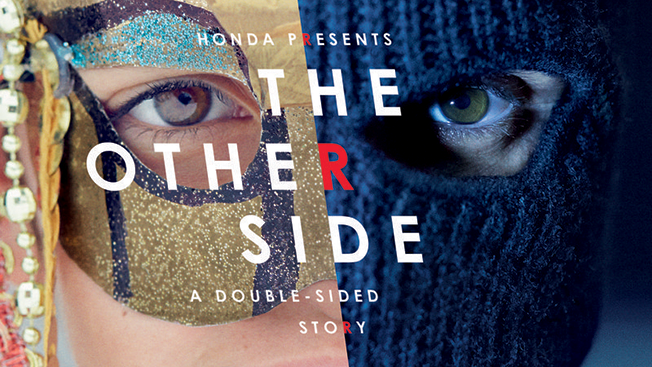
Well, this might just blow your damn mind.
Honda and Wieden + Kennedy London have created a rather incredible “double-sided story” on YouTube to promote the Civic and its sportier sibling, the Civic Type R. While watching “The Other Side,” you can press and hold the “R” button on your keyboard to switch between parallel storylines.
Watch it here: Honda’s “The Other Side.”
“We wanted people to feel Honda’s other side as well as see it,” W+K notes today on its blog, “so we dreamt up a technique that brings together both narratives through a simple interaction.” (The technique is a bit reminiscent of Interlude’s famous interactive music video for Bob Dylan’s “Like a Rolling Stone.”)
Without revealing too much, I’ll just say the dual film directed by Daniel Wolfe follows the travels of a seemingly mild-mannered dad who leads a rather interesting double life.
You can watch a few teasers below, but you really need to go see the full experience for yourself on YouTube.
![]()
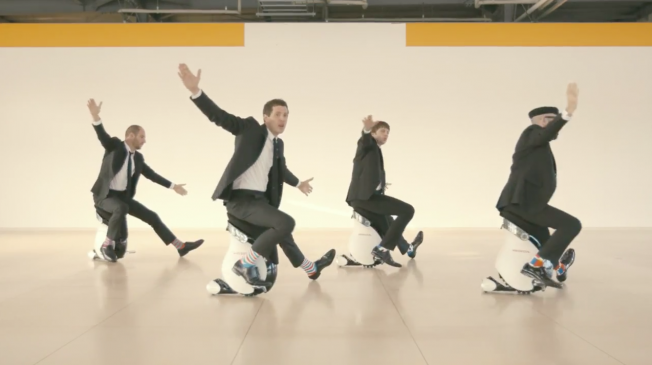
Does OK Go release albums? Like, full-blown records with multiple songs on them? I don’t know. I don’t care. Their videos are enough for all of us.
Japanese creative agency Mori Inc. is behind this one. (You may remember creative director Morihiro Harano, who created that giant xylophone in the woods in that 2011 smartphone ad.) Like all of OK Go’s videos, it’s amazing. I would put it up there with the great Rube Goldberg device video for “This Too Shall Pass,” but maybe not quite as high as the truly awesome collaboration with dance troupe Pilobolus on “All Is Not Lost.”
Anyway, here it is:
Those amazing little motorcycles are the Honda U3-X, a very strange device with some kind of robotic gyroscope inside that keeps it from falling over, even when the guys are leaning back and forth on them. (To be fair, OK Go are samurai warriors when it comes to the art of not falling over.) I don’t want to give away the ending, but it gets nuts from there.
At any rate, the rock world’s answer to Cirque du Soleil is back. Hooray for them, and for us. And also for the drone or helicopter or whatever is filming this thing, because wow.
![]()
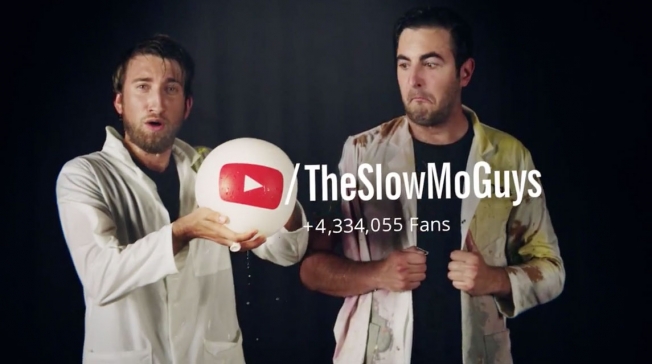
The Slow Mo Guys are shifting into the fast lane.
As part of YouTube’s ongoing effort to introduce its popular channel stars to a wider audience, Gavin Free and Dan Gruchy are appearing in a multimedia push that includes TV, print, billboards and online ads. The campaign, breaking now in the U.K., is tagged “You make every second epic,” and also highlights Vice News and beauty vlog Zoella. (In the U.S., YouTubers like Bethany Mota and Michelle Phan starred in similar ads earlier this year.)
“YouTube stars are not only entertaining us through their quirky videos and updates, but building long lasting relationships with their fans,” says Ben McOwen Wilson, who oversees partnerships for the Google-owned service.
The 30-second Slow Mo Guys teaser shows highlights from some of their nearly 100 videos shot at 10,000 frames per second. Watermelons and paintballs explode in plumes of color, and a teacup tossed through the air disgorges its contents in caramel cascades. This sampling merely hints at the channel’s treasure trove of dazzling footage, which has garnered almost 430 million total views and 4.5 million subscribers in the past four years.
It feels right that The Slow Mo Guys were chosen to take part in YouTube’s mainstream crossover push, because their oeuvre encompasses elements of old and new media. Gavin and Dan condense the frantic, silly vibe of shows like You Can’t Do That on Television and America’s Funniest Home Videos into highly shareable bites. They add dashes of Bill Nye-style scientific curiosity and genuine artistry (some of their slow-motion work is amazing). Even their goofy Brit-bro personalities are in sync with the times, reminding viewers that these are average Joes using technology to create amazing stuff.
At times, the guys present serious, brand-centric material, including a couple of clips that showcase General Electric’s cutting-edge tech. Such efforts are informative and boast hypnotic imagery, but the real fun comes from their sillier escapades. You’ll gasp at the epic cuteness of dogs and cats frozen in mid-air, striking impossible ballet poses. You’ll cringe as milky puke sluggishly slithers from Dan’s twisted, lactose-tortured lips. You’ll jump in your seat when dozens of mousetraps dance in an insanely prolonged (and painful) chain reaction.
These are awesome time wasters. No matter how slow the antics, the minutes fly by.
![]()

For six years, Gregory Ng has held the uncontested title of Frozen Food Master, a grocery guru who has eaten his way through 1,000 microwaved meals and recorded the results for a loyal audience.
But a few days ago, in mid-review, he abruptly quit. The breaking point? A $2 children’s meal that Ng felt was “breading with a hint of chicken on the inside.”
“You know what? I can’t do this anymore,” he said into the camera after a pause. “This is horrible. We should not be feeding our kids this. We should not be eating this frozen food anymore. I’m done with this.”
Obviously, it’s not the frozen food industry that’s changed since Ng’s video review series, Freezerburns, began in 2008. What’s changed is Ng himself.
In recent years, while working his day job as CMO for optimization firm Brooks Bell, Ng has become an advocate for healthy, active living. He even quit Freezerburns briefly in 2012, noting, “I was feeling great every day, and shooting more episodes of Freezerburns was my daily downer.”
He soon returned to the show, reinvigorated with ideas for how to make it better. Today, he estimates the Freezerburns audience across multiple video platforms totals 75,000-100,000 viewers per episode.
This time, though, he says the end is truly the end. In a blog post, he explains how he’s become increasingly uncomfortable with the influence the show has had on his life, such as motivating him to feature the unhealthiest items because he knew they’d be the most popular.
We wanted to know more about his decision to close down a niche he’s spent so much time carving out. Check out our Q&A with Ng below:
AdFreak: So, what are the final stats for your time creating Freezerburns? How much frozen food did you eat? How much video did you create?
Gregory Ng: I published my first episode on Oct. 4, 2008, and in the nearly six years since then I reviewed over 1,000 frozen food items in nearly 700 episodes. One fan calculated that it would take four days to watch every video back to back. Not quite the longevity of The Simpsons marathon, but still a lot of time to watch me eat.
You’re an all-around healthy guy and committed father. Do you feel Freezerburns did more harm than good by promoting the frozen food category?
 Absolutely not! While the issue of healthy eating eventually ended the show for me, the frozen food category as a whole did not and does not contradict my health and my parenting.
Absolutely not! While the issue of healthy eating eventually ended the show for me, the frozen food category as a whole did not and does not contradict my health and my parenting.
There are a ton of items in the freezer aisle that are extremely nasty, unhealthy, sodium-laden and fattening. They truly fit the stereotype of frozen food. But there are also a ton of options that cater to organic, healthy eating as well as special dietary needs like gluten-free or vegetarian.
As the Frozen Food Master, I was able to uncover those gems in the freezer aisle that were great tasting and good for you with the added convenience that frozen meals provide. And when I reviewed things that were great tasting but not great for you, I feel like I represented the tradeoffs in eating them. Because of this, I feel like I promoted the frozen food industry in a positive but realistic way.
How did your “mic drop” moment of walking off set come about? A lot of people would probably assume a scene like that was staged.
In the last couple of months I had a few “moments of clarity” that caused me to question my motivations in keeping my show going. Some of it was simply the time aspect of producing online video in addition to my day job as well as my family commitments and whether the financial benefits outweighed the effort.
I’m typically an impulsive person but I didn’t want to make an impulsive decision to end something I spent a lot of time building. My brand was strong, my relationships with frozen food companies were strong, and my revenue coming in was strong. I had told myself that I would finish out the calendar year. I felt that would be a great time to end things.
Then I reviewed this particular Kid Cuisine meal and I just got very angry during the review. It is geared at kids, and it just isn’t anything I would serve to them. It was also a meal that has a commercial tie-in with the How to Train Your Dragon 2 movie, and the commercialization of the meal made me upset. I record every episode in one take and it just happened. So it wasn’t staged, but there was certainly a buildup to this moment.
You mentioned when you quit that you were starting to be bothered by the fact your audience was closer in age to your kids than yourself. Why was that uncomfortable for you?
I knew that college-aged kids is a great segment to be marketing to, and I exploited that in the beginning years of my show. It fueled a lot of the decisions I made regarding content, publishing times, sponsors I pitched, and merch I designed.
As the years progressed, I tried to evolve the age of my audience into grocery shopping moms. I was successful doing that on my website and on Facebook but not so much on YouTube. My average audience is 19. My oldest child is nearly12. I’m nearly 40.
Good YouTube community management involves conversation and engagement. It was getting to the point where I was no longer aware of what my audience was talking about. And when I dropped a pop culture reference in my dialogue from a movie like Back to the Future, most of them didn’t get it.
You also noted that you felt a bit corrupted by the allure of traffic. Did you feel you were starting to lose control of your content and your own choices?
Absolutely. Over the years, I optimized everything about my show: which items I reviewed to gain the most views and comments, the time to publish, the best way to title my videos for SEO benefits, and the best video length for my audience.
There are a lot of best practices around YouTube optimization but those should just be viewed as guidelines. Every channel is afferent because every show is different. I figured out mine and I didn’t like the decisions I was making to drive more subscribers and revenue.
For example, I would review a Hot Pocket over a vegan Indian meal because I knew the views would be 10 times larger. I could have reviewed what I wanted, but that wasn’t my goal. I was in it to build audience, prove that you could monetize by owning a niche and fine tune my camera presence.
Eventually I realized I accomplished those things and it wasn’t good for me to continue down this path just for a little more revenue.
Like most YouTube personalities, you get a lot of nasty comments. While you seem to have fun mocking them, did they factor into your decision to quit?
Oh no. I know for people not used to publishing a lot on YouTube the troll comments are very scary, emotionally damaging, and offensive. I have always said that a sign that you are popular on YouTube is that the trolls come out. They did not factor into me ending the show.
Do you see yourself starting another ongoing video series with revenue potential? Will you be conquering another niche?
Yes! I am already in the ideation phase of my next project. Freezerburns was the result of careful planning and identifying of a profitable, untapped niche. My next project will be online video-based but not necessarily capitalizing on an exploitable niche. I will not be eating on camera nor will I be reviewing things. This one is coming more from my soul as I will be focusing on crafting behind the camera instead of in front of it. If revenue comes, great. My goal on this one is to create something where the reward is in the emotion it creates.
![]()

YouTube influencer Devin SuperTramp is a man who knows how to get what he wants. And in this case, he wants to ride a 260-foot water slide down the streets of San Francisco.
The video for Bear Naked Granola, with more than 600,000 views in its first few days online, is basically two-and-a-half minutes of young people screeching and squealing as they slosh down the steep track on inflatable rafts, boogie-boards, various rubber sea creatures and, in some cases, their bare bellies.
(I’m sure the locals who spend a zillion dollars for their shoebox-size garden apartments were just thrilled with all the brand-fueled water tomfoolery.)
Street surfing is rapidly becoming a thing. Last year, an artist turned a boulevard in Bristol, England, into a 300-foot water slide to highlight the intricacies and costs of urban planning, because, clearly, only a giant water slide could communicate those complex points.
Check out a behind-the-scenes video below to see the equipment, logistics and rapid jumping reflexes required to pull off a shoot like this.
![]()
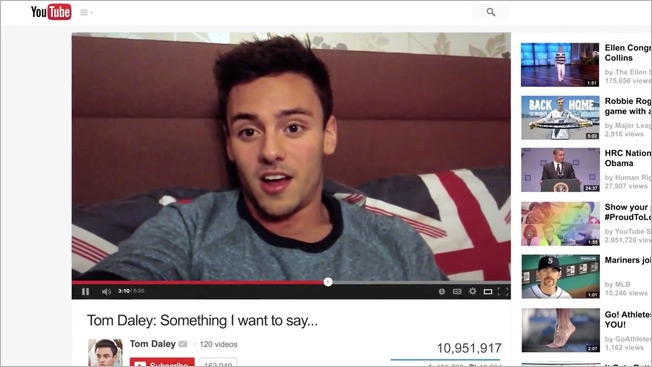
Jason Collins. Michael Sam. Robbie Rogers. It’s been an eventful couple of years for athletes coming out publicly in professional sports. And now, YouTube, a longtime supporter of gay rights, is celebrating diversity in sports with a campaign themed #ProudToPlay, set to run all through June, which is LGBT Pride Month and also will include the first two weeks of the World Cup in Brazil.
A star-studded anthem spot from 72andSunny features clips of everyone from Nelson Mandela to President Obama to Kobe Bryant talking about both the transcendent power of sports and the courage of gay athletes to be open in a sometimes hostile environment.
“We applaud the courage and openness of athletes at all levels who have come out and admire their teammates, friends, families, and supporters who are all proving that it doesn’t matter who you are or who you love—what matters is that you put forward your best effort,” YouTube says in a blog post.
“We stand with our community in the belief that youth everywhere should all have the same opportunities to grow up and pursue their dreams and passions, on or off the field.”
![]()
Vídeo já não é mais algo que as pessoas conferem apenas no desktop. Uma pesquisa da Sandvine, que analisou o tráfego de dados mobile nos EUA, revelou que o YouTube é o site mais acessado através de dispositivos móveis, responsável por 17,26% dos dados baixados em aparelhos móveis, seguido pelo Facebook, com 14,76%.
O upload de informações, contudo, inverte a ordem: o Facebook aparece concentrando 26,9% dos dados ‘upados’, contra apenas 3,7% do YouTube – provavelmente relacionado a vídeos que são colocados no ar sem ou com pouquíssima edição, já que essa tarefa é melhor realizada por computadores desktop ou notebooks (e que acabam sendo enviadas para o site a partir desses dispositivos mesmo).
O Netflix aparece na oitava posição, atrás do tráfego de download da Google Play e do serviço de streaming Pandora, mas acima do tráfego gerado por serviços como o Instagram e iTunes.
 Post originalmente publicado no Brainstorm #9
Post originalmente publicado no Brainstorm #9
Twitter | Facebook | Contato | Anuncie